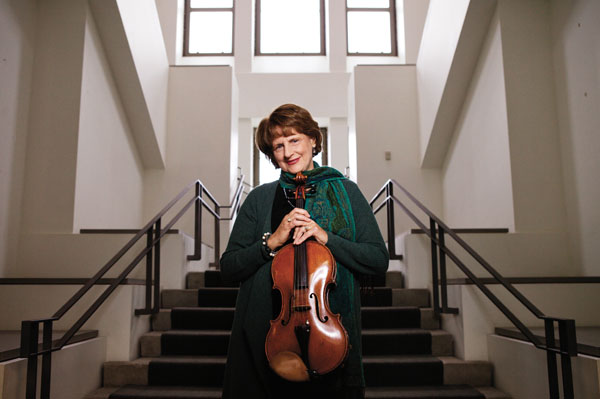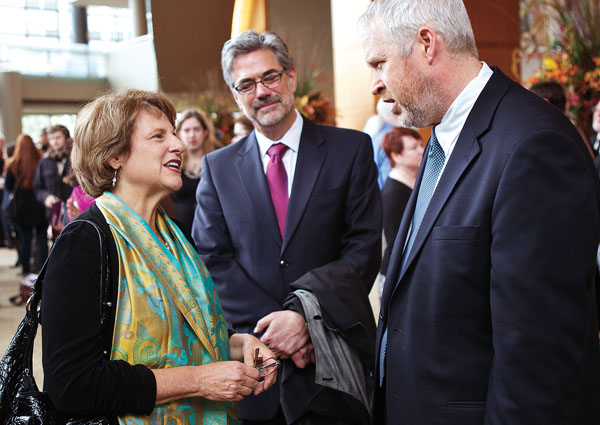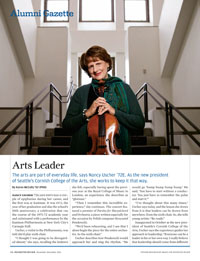Alumni Gazette
 USCHERED IN: Violist Uscher (above) was inaugurated as president of Cornish College of the Arts this fall, a celebration whose guests included Seattle Mayor Mike McGinn (below) and John Gordon Hill, the chair of Cornish’s board of trustees. (Photo: Stephen Brashear/AP Images for Rochester Review)
USCHERED IN: Violist Uscher (above) was inaugurated as president of Cornish College of the Arts this fall, a celebration whose guests included Seattle Mayor Mike McGinn (below) and John Gordon Hill, the chair of Cornish’s board of trustees. (Photo: Stephen Brashear/AP Images for Rochester Review)Nancy Uscher ’72E says she’s had a couple of epiphanies during her career, and the first was at Eastman. It was 1972, the year of her graduation and also the school’s 50th anniversary, a celebration that ran the course of the 1971–72 academic year and culminated with a performance by the Eastman Philharmonia at New York City’s Carnegie Hall.
Uscher, a violist in the Philharmonia, was told she’d play sixth chair.
“I thought I was going to be disregarded almost,” she says, recalling the letdown she felt, especially having spent the previous year at the Royal College of Music in London, an experience she describes as “glorious.”
“Then I remember this incredible experience,” she continues. The concert featured a premier of Partita for Harpsichord and Orchestra, a piece written especially for the occasion by Polish composer Krzysztof Penderecki.
“We’d been rehearsing, and I see that I alone begin the piece for the entire orchestra. As the sixth chair.”
Uscher describes how Penderecki would approach her and sing the rhythm. “He would go ‘bump bump bump bump.’ He said, ‘You have to start without a conductor. You just have to remember the pulse and start it.’”
“I’ve thought about this many times,” Uscher says today, and the lesson she draws from it is that leaders can be drawn from anywhere. Even the sixth chair. So, she tells young artists: “Be ready.”
 (Photo: Stephen Brashear/AP Images for Rochester Review)
(Photo: Stephen Brashear/AP Images for Rochester Review)Inaugurated in October as the new president of Seattle’s Cornish College of the Arts, Uscher says the experience guides her approach to leadership. “Everyone can be a leader in his or her own way. I really believe that leadership should come from different sectors, and I don’t like micromanagement.”
Uscher has herself come from many different sectors of the arts world. After graduating from Eastman, she pursued scholarly and performance paths simultaneously, pursuing a doctorate in music at New York University and advanced study in viola at Juilliard. A series of guest teaching assignments and residencies took her around the world. And for six years, she was coprincipal violist in the Jerusalem Symphony Orchestra.
She returned to the United States in 1984, eventually focusing on scholarship and academic leadership, working her way up to associate provost of academic affairs at the University of New Mexico, then provost of the California Institute of the Arts (or, CalArts), before being tapped as president of Cornish. In 1999, she returned to Eastman and delivered a talk, “The Artist’s Leadership Challenge: Defining Career Opportunity for a Changing World,” as part of the Arts Leadership guest speaker series.
Uscher says Cornish offers “a very unusual model.” It was founded almost a century ago by Seattle pianist and educator Nellie Cornish, who wanted her students to experience the “interrelatedness” of all the arts. In 1977, the school became an accredited college, offering bachelor’s degrees in visual arts, design, theater, music, dance, and performance production. With the exception of only two arts colleges she can think of—her previous employer, CalArts, and Philadelphia’s University of the Arts—Uscher notes that colleges of the arts are either colleges of the visual arts or colleges of the performing arts.
“It changes the context in which you learn,” she says, adding that at CalArts, the tendency of visual artists to articulate the concepts behind their work encouraged her to do the same as a musician.
In the 1930s, the Cornish faculty included the dancer Martha Graham and was the place where the avant-garde composer John Cage and the dancer and choreographer Merce Cunningham met one another and began their lifelong collaboration and partnership.
Nonetheless, the school floundered for decades following Cornish’s retirement as president, and its accreditation as a college in the 1970s failed to revive it. In the past decade, however, the college has experienced a notable turnaround, securing a move downtown, the integration and improvement of physical facilities, and growing visibility in the Seattle arts community and beyond.
With these changes, Uscher says, “Now we’re in a position to really fulfill our promise.”
Paul Nathanson, who’s the executive director of the National Senior Citizens Law Center and helped Uscher establish a Center for the Arts in Society when they were both at the University of New Mexico, thinks she’s well poised for the role. He recalls her success in designing innovative programs to bring arts into the community, and in finding funders to help them thrive.
“She’ll be able to push an agenda that shows the interconnectedness of the arts, and of the arts in society,” he says. In the music department at New Mexico, he adds, “Some of the faculty were pretty straight about what they were doing. Their attitude was, we’re doing composing, we’re playing, and the rest of this stuff”—such as Uscher’s activities at the center—“is just sort of weird. Nancy has a broad vision of the arts.”
Indeed, Uscher says if there’s one thing she wants to communicate to young artists, it’s that “they have a huge role in our world.” And lest anyone think that’s mere platitude, Uscher has an illustration of exactly what she means—her second epiphany, which occurred while she was in New Mexico.
She was on a town hall tour, in which the new president of the university and other leaders ventured far from the flagship Albuquerque campus into the mostly rural state, to see how the University could meet the needs of the state’s far-flung communities. In one of the towns, a young university doctor who had been offered a job to become that town’s only physician stood up and said, according to Uscher’s recollection: “You’ve offered me a really high salary, and I thank you, but I can’t come here, because my daughter can’t take ballet lessons, and I can’t go to a museum, and I can’t go to the theater and have my ideas challenged.”
It was a powerful illustration to Uscher of the centrality of arts to thriving communities.
“This is not separate,” she says, referring to the arts, and to her life’s work in helping to bring them to as many places and people as she can. “It’s integrated into the way people are thinking about their lives.”

